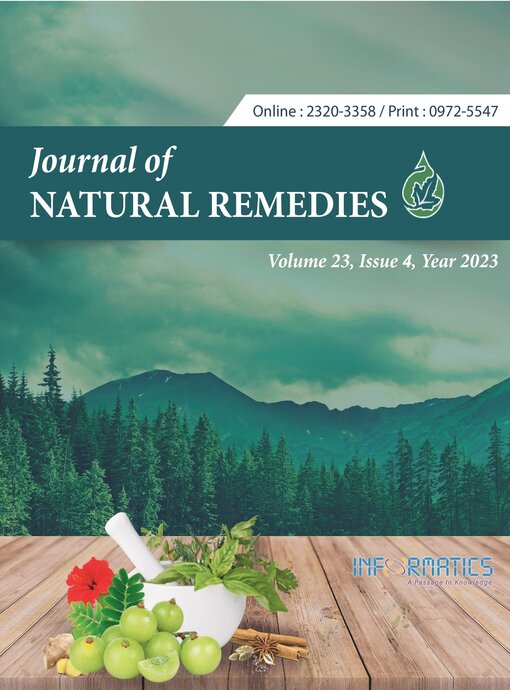Hepatoprotective Efficacy of Phytochemically Screened Nyctanthes arbor-tristis
DOI:
https://doi.org/10.18311/jnr/2023/33791Keywords:
Hepatoprotective Efficacy, Nyctanthes arbor-tristis, Phytochemical ScreeningAbstract
The Oleaceae plant Nyctanthes arbor-tristis Linnaeus is used in Ayurveda medicine as a laxative, diuretic, and for the treatment of a variety of painful conditions including sciatica, arthritis, and fever. This study aimed to determine whether or not extracts of Nyctanthes arbor-tristis leaves, either in alcohol or water, might prevent liver damage caused by carbon tetrachloride in rats. Administration of alcoholic and aqueous extracts of the leaves of Nyctanthes arbor-tristis protects the liver against the toxicity of carbon tetrachloride by lowering the high levels of serum glutamate pyruvate transaminase, serum glutamate oxaloacetate transaminase, and serum bilirubin (total and direct). Both the alcoholic and aqueous extracts demonstrated hepatoprotective efficacy at a dosage of 500 mg/kg body weight by significantly reducing the high levels of biochemical markers. Liver histopathology studies corroborated the extracts’ potential to restore damaged hepatocytes.
Downloads
Metrics
Downloads
Published
How to Cite
Issue
Section
License
Copyright (c) 2022 Ajay Sharma, Shailesh Kewatkar, Jeevan S. Dhumal, Gaurav Jain, Akanksha Jagwani, Amit Joshi, Har Goving Garg (Author)

This work is licensed under a Creative Commons Attribution 4.0 International License.
Accepted 2023-07-14
Published 2023-11-09
References
Das S, Sasmal D. Studies of certain pharmacological activities of the flowers and seeds of Nyctanthes arbor-tristis. Indian Journal of Pharmacology. 2003; 35(3):194-201.
Kokate CK, Gokhale SB. Practical pharmacognosy. In: Physical and chemical testes for evaluation of crude drugs, 12th Ed., Pune: Nirali Prakashan; 2008. p. 14-19, 107-111, 121.
Khandelwal KR. Practical pharmacognosy, In: Preliminary phytochemical screening. Pune: Nirali Prakashan; 2004. p. 149-153 and 157-159.
CPCSEA. CPCSEA guidelines for laboratory animal facility. Indian Journal of Pharmacology. 2003; 35(3):257-274.
Rabiul H, Subhasish M, Sinha S, Roy MG, Sinha D, Gupta S. Hepatoprotective activity of Clerodendron inerme against paracetamol induced hepatic injury in rats for pharmaceutical product. International Journal of Drug Development and Research. 2011; 3(1):118-126.
Balakrishnan N, Balasubramaniam A, Balakrishnan S. Hepatoprotective activity of two Indian medicinal plants from western ghats, Tamil Nadu. Journal of Natural Pharmaceuticals. 2011; 2(2):92. DOI: https://doi.org/10.4103/2229-5119.83963
Ahmed B, Alam T, Varshney M, Khan A. Hepatoprotective activity of two plants belonging to the Apiaceae and the Euphorbiaceae family. Journal of Ethnopharmacology. 2002; 79(3):313-316. https://doi.org/10.1016/S0378-8741(01)00392-0 DOI: https://doi.org/10.1016/S0378-8741(01)00392-0
Amin A, Lotfy M, Ullah MS, Adeghate E. The protective effect of Tribulus Terrestris in diabetes. Annals of the New York Academy of Sciences. 2006; 1084(1):391-401. https://doi.org/10.1196/annals.1372.005 DOI: https://doi.org/10.1196/annals.1372.005
Arulkumaran KS, Rajasekaran A, Ramasamy A, Jegadeesan M, Kavimani S, Somasundaram A. Cassia roxburghii seeds protect liver against toxic effects of ethanol and carbon tetrachloride in rats. International Journal of PharmTech Research. 2009; 1(2):273-246.
Asha VV, Akhila S, Wills PJ, Subrammaniam A. Further studies on the antihepatotoxic activity of Phyllanthus maderaspatensis Linn. Journal of Ethnopharmacology. 2004; 92(1):67-70. https://doi.org/10.1016/j.jep.2004.02.005 DOI: https://doi.org/10.1016/j.jep.2004.02.005
Bhaskar VH, Balakrishnan N. Hepatoprotective activity of Lactiferous plant species (Pergularia daemia and Carissa carandas) from Western Ghats, Tamil Nadu, India. International Journal of Health Research. 2009; 2(2):163-170. https://doi.org/10.4314/ijhr.v2i2.55413 DOI: https://doi.org/10.4314/ijhr.v2i2.55413
Bhattacharya D, Pandit S, Mukherjee R, Das N, Sur TK. Hepatoprotective effect of Himolive, a polyherbal formulation in rats. Indian Journal of Physiology and Pharmacology. 2003; 47(4):435-440.
Bhattacharyya D, Pandit S, Jana U, Sen S, Sur TK. Hepatoprotective activity of Adhatoda vasica aqueous leaf extract on D galactosamine – Induced liver damage in rats. Fitoterapia. 2005; 76(2):223. https://doi.org/10.1016/j.fitote.2004.10.014 DOI: https://doi.org/10.1016/j.fitote.2004.10.014
Devi PK, Sreepriya M, Balakrishna K, Devaki T. Protective effect of Premna tomentosa (L. Verbenaceae) extract on membrane bound phosphatases and inorganic cations transport in acetaminophen induced hepatotoxicity rats. Journal of Ethnopharmacology. 2004; 93(2-3):371-375. https://doi.org/10.1016/j.jep.2004.04.010 DOI: https://doi.org/10.1016/j.jep.2004.04.010
Remington JR. In: Gennaro AR, editor. The science and practice of pharmacy. Philadelphia: Lipincott Williams and Wilkins; 2000. p. 1088-1090.
Germano MP, D’Angelo V, Sanogo R, Catania S, Alma R, De Pasquale R, et al. Hepatoprotective and antibacterial effects of extracts from Trichilia emetica vahl. (Meliaceae). Journal of Ethnopharmacology. 2005; 4(1-2):227-232. https://doi.org/10.1016/j.jep.2004.09.011 DOI: https://doi.org/10.1016/j.jep.2004.09.011
Ghadi PS. Disorders of liver: Pathophysiology for pharmacy. 2nd ed. Nashik: Career Publications; 2000. p. 106-108 and 125-130.
Hajimehdipoor H, Sadeghi Z, Elmi S, Elmi A, Ghazi Khansari M, Amanzadeh Y et al. Protective effects of Swertia longifolia Boiss. and its active compound, swerchirin, on paracetamol induced hepatotoxicity in mice. Journal of Pharmacy and Pharmacology. 2006; 58(2):277-280. https://doi.org/10.1211/jpp.58.2.0017 DOI: https://doi.org/10.1211/jpp.58.2.0017
Handa SS, Kapoor VK. A text book of pharmacognosy. 2nd ed., Delhi: Balaji Offset Printers; 2005. p. 9-10.
Hardman JG, Limbird LE. Ethanol Chapter 18 In: Goodman and Gilman’s The Pharmacological basis of Therapeutics, 10th Ed, McGraw – Hill Medical Publishing Division; 2001. p. 434.
Mohan H. Text book of pathology, 4th ed, New Delhi: Jaypee brothers Medical Publishers (P) Ltd.; 2000. p. 599 and 602, 603.
Mohan H. The liver, biliary tract, and exocrine pancreas. In: Text book of Pathology, 4th Ed., New Delhi: Jaypee Brothers Medical Publishers (P) Ltd.; 2002. p. 22-24, 569-630.
Hemieda FA, Abdel-Hady El SK, Elnga MAA. Biochemical and histological studies on H2 receptor antagonist ranitidine induced hepatotoxicity in rats. Indian Journal of Experimental Biology. 2005; 43(9):782-5.
Jung SH, Lee YS, Lim SS, Lee S, Shin KH, Kim YS. Antioxidant activities of isoflavones from the rhizomes of Belamcanda chinensis on carbon tetrachloride induced hepatic injury in rats. Archives of Pharmacal Research. 2004; 27(2):184-188. https://doi.org/10.1007/BF02980104 DOI: https://doi.org/10.1007/BF02980104
Kokate CK, Gokhale SB. Practical Pharmacognosy, 12th Ed. In: Physical and Chemical Testes for Evaluation of Crude Drugs, Pune : Nirali Prakashan; 2008. p. 14-19, 107-111 and 121.
Kokate CK, Purohit AP, Gokhale SB. Pharmacognosy (31st Ed). In: Traditional and Alternative System of Medicine, Pune: Nirali Prakshan; 2005. p. 4-5.
Mohan GK, Pallavi E, Kumar BR, Ramesh M, Venkatesh S. Hepatoprotective activity of Ficus carica (Linn) leaf extract against carbon tetrachloride induced hepatotoxicity in rats. DARU Journal of Pharmaceutical Sciences. 2007; 15(3):162-167.

 Ajay Sharma
Ajay Sharma









 0.35
0.35 24
24 0.161
0.161